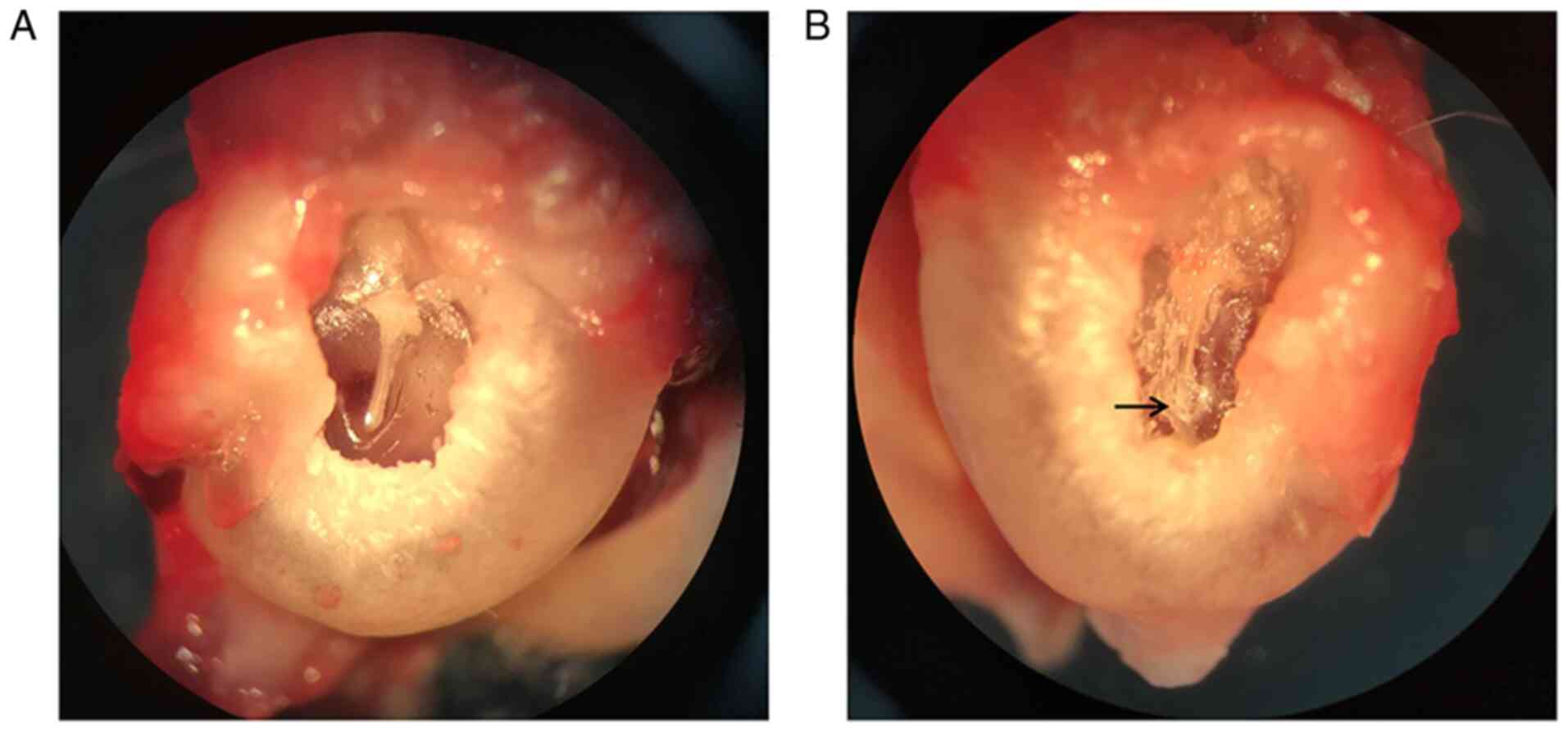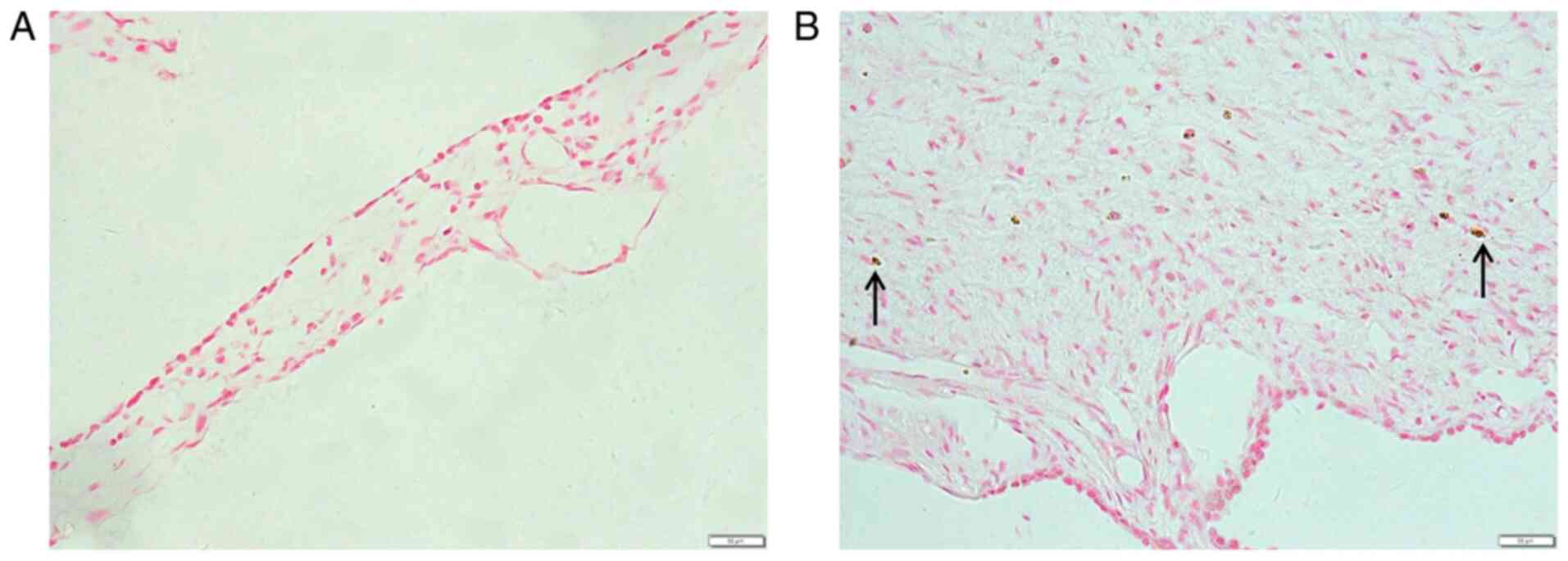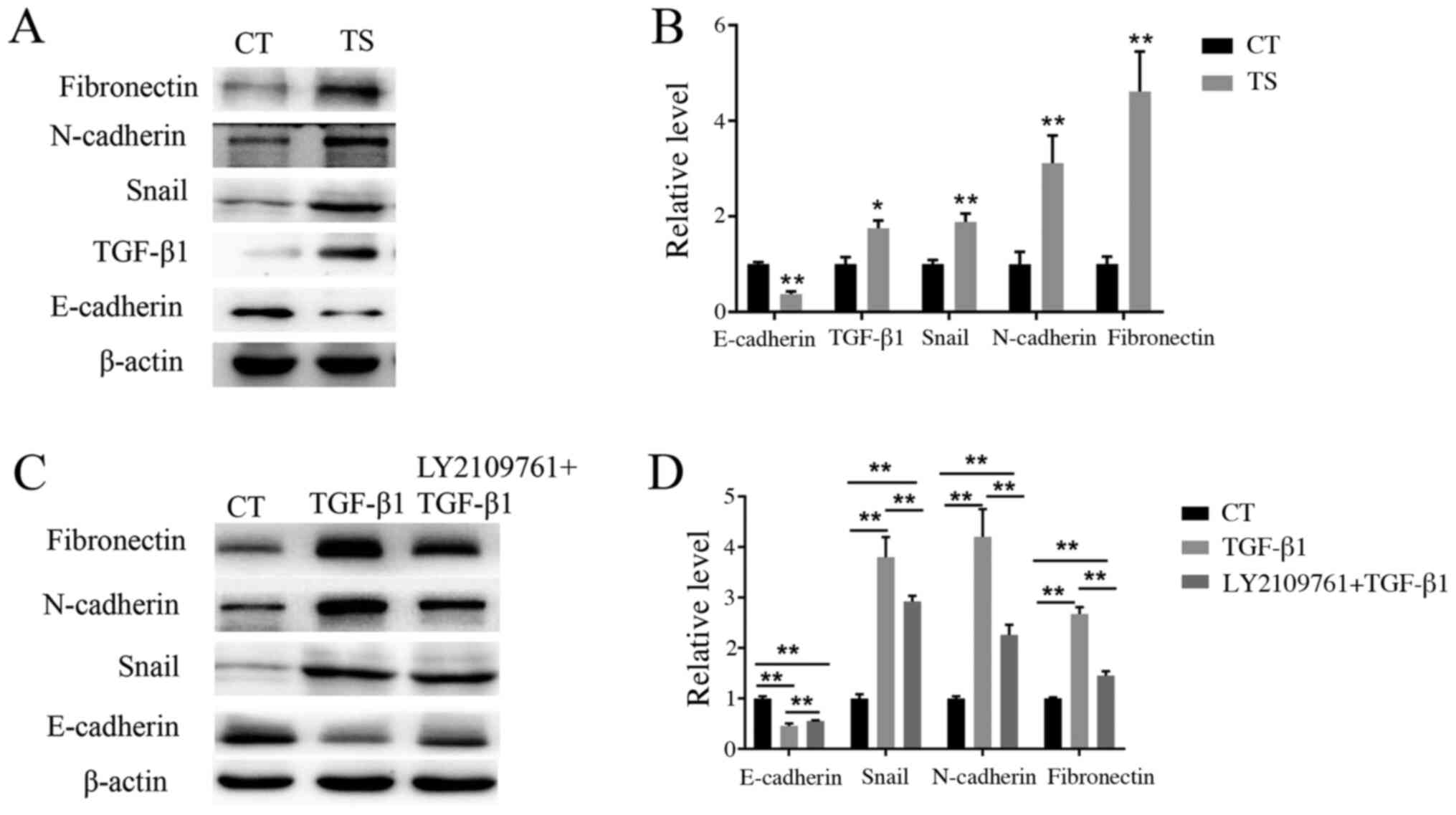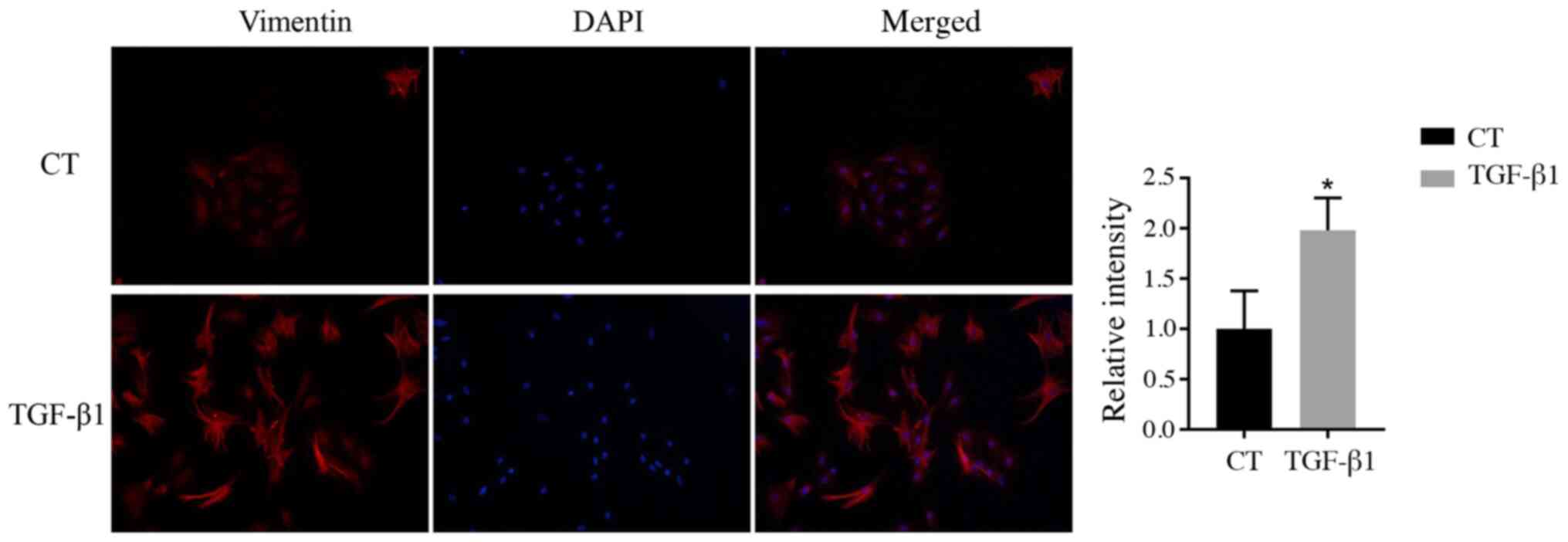|
1
|
Zhang Y, Wang S, Zheng Y and Liu A:
Possible role of dickkopf-1 protein in the pathogenesis of
tympanosclerosis in a rat model. J Laryngol Otol. 131:860–865.
2017.PubMed/NCBI View Article : Google Scholar
|
|
2
|
Qiu JJ, Wang JX and Sun Y: Advances in
research on etiology of tympanosclerosis and related factors. Chin
J Otol. 18:792–796. 2020.
|
|
3
|
Asiri S, Hasham A, Al Anazy F, Zakzouk S
and Banjar A: Tympanosclerosis: Review of literature and incidence
among patients with middle-ear infection. J Laryngol Otol.
113:1076–1080. 1999.PubMed/NCBI View Article : Google Scholar
|
|
4
|
Wu Y, Yin S, Zhu H and Zhang S:
Tympanosclerosis incidence among patients with chronic suppurative
otitis media. Lin Chuang Er Bi Yan Hou Ke Za Zhi. 20:1016–1017.
2006.PubMed/NCBI View Article : Google Scholar : (In Chinese).
|
|
5
|
Branco C, Monteiro D and Paco J:
Predictive factors for the appearance of myringosclerosis after
myringotomy with ventilation tube placement: Randomized study. Eur
Arch Otorhinolaryngol. 274:79–84. 2017.PubMed/NCBI View Article : Google Scholar
|
|
6
|
Wrzesinski SH, Wan YY and Flavell RA:
Transforming growth factor-beta and the immune response:
Implications for anticancer therapy. Clin Cancer Res. 13:5262–5270.
2007.PubMed/NCBI View Article : Google Scholar
|
|
7
|
Fabregat I, Moreno-Caceres J, Sanchez A,
Dooley S, Dewidar B, Giannelli G and Ten Dijke P: IT-LIVER
Consortium. TGF-β signalling and liver disease. FEBS J.
283:2219–2232. 2016.PubMed/NCBI View Article : Google Scholar
|
|
8
|
Berksoy Hayta S, Durmus K, Altuntas EE,
Yildiz E, Hisarciklio M and Akyol M: The reduction in inflammation
and impairment in wound healing by using strontium chloride
hexahydrate. Cutan Ocul Toxicol. 37:24–28. 2018.PubMed/NCBI View Article : Google Scholar
|
|
9
|
Zhang X, Zhang MC and Wang CT: Loss of
LRRC25 accelerates pathological cardiac hypertrophy through
promoting fibrosis and inflammation regulated by TGF-β1. Biochem
Biophys Res Commun. 506:137–144. 2018.PubMed/NCBI View Article : Google Scholar
|
|
10
|
Melhus A and Ryan AF: Expression of
cytokine genes during pneumococcal and nontypeable haemophilus
influenzae acute otitis media in the rat. Infect Immun.
68:4024–4031. 2000.PubMed/NCBI View Article : Google Scholar
|
|
11
|
Guo W, Bai X, Han Y, Xu L, Liu W, Zhang G,
Li J, Fan Z and Wang H: Expressions of TGF-β1 and MMP-9 in a guinea
pig model of tympanosclerosis: Possible role in the pathogenesis of
this disorder. Laryngoscope. 122:2037–2042. 2012.PubMed/NCBI View Article : Google Scholar
|
|
12
|
Wang X, Gao JL, Zhao MM, Zhu HX, Tian YX,
Li R, Jiang XH, Yu L, Tian JR and Cui JZ: Therapeutic effects of
conditioned medium from bone marrow-derived mesenchymal stem cells
on epithelial-mesenchymal transition in A549 cells. Int J Mol Med.
41:659–668. 2018.PubMed/NCBI View Article : Google Scholar
|
|
13
|
Stone RC, Pastar I, Ojeh N, Chen V, Liu S,
Garzon KI and Tomic-Canic M: Epithelial-mesenchymal transition in
tissue repair and fibrosis. Cell Tissue Res. 365:495–506.
2016.PubMed/NCBI View Article : Google Scholar
|
|
14
|
Guarino M, Tosoni A and Nebuloni M: Direct
contribution of epithelium to organ fibrosis:
Epithelial-mesenchymal transition. Hum Pathol. 40:1365–1376.
2009.PubMed/NCBI View Article : Google Scholar
|
|
15
|
Sisto M, Lorusso L, Ingravallo G, Tamma R,
Ribatti D and Lisi S: The TGF-β1 signaling pathway as an attractive
target in the fibrosis pathogenesis of sjogren's syndrome.
Mediators Inflamm. 2018(1965935)2018.PubMed/NCBI View Article : Google Scholar
|
|
16
|
Chen Q, Yang W, Wang X, Li X, Qi S, Zhang
Y and Gao MQ: TGF-β1 induces EMT in bovine mammary epithelial cells
through the TGFβ1/smad signaling pathway. Cell Physiol Biochem.
43:82–93. 2017.PubMed/NCBI View Article : Google Scholar
|
|
17
|
Zhu X, Li Q, Hu G, Wang J, Hu Q, Liu Z, Wu
G and Zhong Y: BMS345541 inhibits airway inflammation and
epithelialmesenchymal transition in airway remodeling of asthmatic
mice. Int J Mol Med. 42:1998–2008. 2018.PubMed/NCBI View Article : Google Scholar
|
|
18
|
Yang HW, Lee SA, Shin JM, Park IH and Lee
HM: Glucocorticoids ameliorate TGF-β1-mediated
epithelial-to-mesenchymal transition of airway epithelium through
MAPK and Snail/Slug signaling pathways. Sci Rep.
7(3486)2017.PubMed/NCBI View Article : Google Scholar
|
|
19
|
Peinado H, Quintanilla M and Cano A:
Transforming growth factor beta-1 induces snail transcription
factor in epithelial cell lines: Mechanisms for epithelial
mesenchymal transitions. J Biol Chem. 278:21113–21123.
2003.PubMed/NCBI View Article : Google Scholar
|
|
20
|
Wu T, Liu T, Xing L and Ji G: Baicalin and
puerarin reverse epithelial-mesenchymal transition via the
TGF-beta1/Smad3 pathway in vitro. Exp Ther Med.
16:1968–1974. 2018.PubMed/NCBI View Article : Google Scholar
|
|
21
|
U.S. Department of Agriculture 2001. Code
of Federal Regulations, Animal Welfare Act and Regulation chapter
1, subchapter A: Animals and animal products. U.S. Department of
Agriculture, Beltsville, MD.
|
|
22
|
Emir H, Kaptan ZK, Samim E, Sungu N,
Ceylan K and Ustun H: The preventive effect of ginkgo biloba
extract in myringosclerosis: Study in rats. Otolaryngol Head Neck
Surg. 140:171–176. 2009.PubMed/NCBI View Article : Google Scholar
|
|
23
|
Anonymous AVMA Guidelines for the
Euthanasia of Animals. 2013 edition. American Veterinary Medical
Association, Schaumburg, IL, 2013.
|
|
24
|
Chen L, Huang YL, Wang J and You JM:
Effect of platelet activating factor on mucous glycoprotein
secretion in culture middle ear epithelium cells. Guangdong Med J
698-700, 2003.
|
|
25
|
Nakamura A, DeMaria TF, Lim DJ and van
Blitterswijk CA: Primary culture of chinchilla middle ear
epithelium. Ann Otol Rhinol Laryngol. 100:774–782. 1991.PubMed/NCBI View Article : Google Scholar
|
|
26
|
Han F, Shu J, Wang S, Tang CE and Luo F:
Metformin inhibits the expression of biomarkers of fibrosis of EPCs
in vitro. Stem Cells Int. 2019(9019648)2019.PubMed/NCBI View Article : Google Scholar
|
|
27
|
Li J, Peng W, Yang P, Chen R, Gu Q, Qian
W, Ji D, Wang Q, Zhang Z, Tang J and Sun Y: MicroRNA-1224-5p
inhibits metastasis and epithelial-mesenchymal transition in
colorectal cancer by targeting SP1-mediated NF-κB signaling
pathways. Front Oncol. 10(294)2020.PubMed/NCBI View Article : Google Scholar
|
|
28
|
Zhang YF, Zheng YX, Wang SJ, Peng LY, He C
and Liu AG: Comparison of two methods for the modeling of
tympanosclerosis in rat. J Audiol Speech Pathol. 25:284–287.
2017.PubMed/NCBI View Article : Google Scholar
|
|
29
|
Russell JD and Giles JJ: Tympanosclerosis
in the rat tympanic membrane: An experimental study. Laryngoscope.
112:1663–1666. 2002.PubMed/NCBI View Article : Google Scholar
|
|
30
|
Koc S, Kiyici H, Toker A, Soyaliç H, Aslan
H, Kesici H and Karaca ZI: The effect of melatonin and vitamin C
treatment on the experimentally induced tympanosclerosis: Study in
rats. Braz J Otorhinolaryngol. 83:541–545. 2017.PubMed/NCBI View Article : Google Scholar
|
|
31
|
Santos PF, Leal MC, Peixoto C, Caldas Neto
S and Rosas ST: Otomicroscopic and histologic findings of induced
myringosclerosis in rats: A critical study of an experimental
model. Braz J Otorhinolaryngol. 71:668–674. 2005.PubMed/NCBI View Article : Google Scholar
|
|
32
|
Mahmoud AM, Hozayen WG, Hasan IH, Shaban E
and Bin-Jumah M: Umbelliferone ameliorates CCl(4)-induced liver
fibrosis in rats by upregulating PPARγ and attenuating oxidative
stress, inflammation, and TGF-β1/Smad3 signaling. Inflammation.
42:1103–1116. 2019.PubMed/NCBI View Article : Google Scholar
|
|
33
|
Kania G, Blyszczuk P and Eriksson U:
Mechanisms of cardiac fibrosis in inflammatory heart disease.
Trends Cardiovasc Med. 19:247–252. 2009.PubMed/NCBI View Article : Google Scholar
|
|
34
|
Lopez-Novoa JM and Nieto MA: Inflammation
and EMT: An alliance towards organ fibrosis and cancer progression.
EMBO Mol Med. 1:303–314. 2009.PubMed/NCBI View Article : Google Scholar
|
|
35
|
Sato M, Muragaki Y, Saika S, Roberts AB
and Ooshima A: Targeted disruption of TGF-beta1/Smad3 signaling
protects against renal tubulointerstitial fibrosis induced by
unilateral ureteral obstruction. J Clin Invest. 112:1486–1494.
2003.PubMed/NCBI View Article : Google Scholar
|
|
36
|
Loboda A, Sobczak M, Jozkowicz A and Dulak
J: TGF-β1/Smads and miR-21 in renal fibrosis and inflammation.
Mediators Inflamm. 2016(8319283)2016.PubMed/NCBI View Article : Google Scholar
|
|
37
|
Yang YC, Zhang N, Van Crombruggen K, Hu
GH, Hong SL and Bachert C: Transforming growth factor-beta1 in
inflammatory airway disease: A key for understanding inflammation
and remodeling. Allergy. 67:1193–1202. 2012.PubMed/NCBI View Article : Google Scholar
|
|
38
|
Cooter MS, Eisma RJ, Burleson JA, Leonard
G, Lafreniere D and Kreutzer DL: Transforming growth factor-beta
expression in otitis media with effusion. Laryngoscope.
108:1066–1070. 1998.PubMed/NCBI View Article : Google Scholar
|
|
39
|
Rout-Pitt N, Farrow N, Parsons D and
Donnelley M: Epithelial mesenchymal transition (EMT): A universal
process in lung diseases with implications for cystic fibrosis
pathophysiology. Respir Res. 19(136)2018.PubMed/NCBI View Article : Google Scholar
|
|
40
|
Altrock E, Sens C, Wuerfel C, Vasel M,
Kawelke N, Dooley S, Sottile J and Nakchbandi IA: Inhibition of
fibronectin deposition improves experimental liver fibrosis. J
Hepatol. 62:625–633. 2015.PubMed/NCBI View Article : Google Scholar
|
|
41
|
Iredale JP: Models of liver fibrosis:
Exploring the dynamic nature of inflammation and repair in a solid
organ. J Clin Invest. 117:539–548. 2007.PubMed/NCBI View Article : Google Scholar
|
|
42
|
Kriegel AJ, Fang Y, Liu Y, Tian Z,
Mladinov D, Matus IR, Ding X, Greene AS and Liang M:
MicroRNA-target pairs in human renal epithelial cells treated with
transforming growth factor beta 1: A novel role of miR-382. Nucleic
Acids Res. 38:8338–8347. 2010.PubMed/NCBI View Article : Google Scholar
|
|
43
|
Dzamba BJ, Jakab KR, Marsden M, Schwartz
MA and DeSimone DW: Cadherin adhesion, tissue tension, and
noncanonical Wnt signaling regulate fibronectin matrix
organization. Dev Cell. 16:421–432. 2009.PubMed/NCBI View Article : Google Scholar
|
|
44
|
Chaffer CL, San Juan BP, Lim E and
Weinberg RA: EMT, cell plasticity and metastasis. Cancer Metastasis
Rev. 35:645–654. 2016.PubMed/NCBI View Article : Google Scholar
|
|
45
|
Park YJ, Bang IJ, Jeong MH, Kim HR, Lee
DE, Kwak JH and Chung KH: Effects of β-sitosterol from corn silk on
TGF-β1-induced epithelial-mesenchymal transition in lung alveolar
epithelial cells. J Agric Food Chem. 67:9789–9795. 2019.PubMed/NCBI View Article : Google Scholar
|
|
46
|
Lee HY, Kim IK, Yoon HK, Kwon SS, Rhee CK
and Lee SY: Inhibitory effects of resveratrol on airway remodeling
by transforming growth factor-β/smad signaling pathway in chronic
asthma model. Allergy Asthma Immunol Res. 9:25–34. 2017.PubMed/NCBI View Article : Google Scholar
|
|
47
|
Kee JY, Han YH, Mun JG, Park SH, Jeon HD
and Hong SH: Effect of Korean red ginseng extract on colorectal
lung metastasis through inhibiting the epithelial-mesenchymal
transition via transforming growth
factor-β1/Smad-signaling-mediated Snail/E-cadherin expression. J
Ginseng Res. 43:68–76. 2019.PubMed/NCBI View Article : Google Scholar
|



















